Functions, Composition, Organization - Planning Commission of India | 12th Political Science : Chapter 8 : Planning and Development Politics
Chapter: 12th Political Science : Chapter 8 : Planning and Development Politics
Planning Commission of India
Planning Commission of India
The Planning Commission of India
was set up in March 1950 by a resolution of the Government of India under the
chairmanship of Pandit Jawaharlal Nehru the first Prime Minister of India, to prepare
a plan for the “most effective and balanced utilization of the country’s
resources”. The Planning Commission played an advisory role with regard to the
formulation of the plans. It was the duty of the Central and state governments to
implement the planning programmes.
Functions of Planning Commission
The Planning Commission had the
function of assessing the resources of the nation so that they could be
developed for the future needs of the country. These included material, capital
and human resources. It was the primary duty of the Commission to prepare the
plans so that these resources could be used in an effective and balanced
manner. The resources had to be allocated among various sectors as per
priorities and the stages of progress and completion of programmes was to be
laid down to the Commission. The Commission had to identify the conditions and
issues that would be a hindrance for development.
It had to examine the ways by
which the plan could be effectively implemented in the prevailing conditions of
the nation. It also determined the stage by stage execution of the plan. The
planning process had to be assessed periodically so that right strategies could
be used to implement the plans. In the process, the Planning Commission had the
function of advising the central and state governments with regard to the
appropriate strategies of planning. The Commission also had to analyse
particular issues and advice on it to the government. It was the role of the
Commission to determine the rate of growth of the economy specifying the
targets of the plan period for every sector.
Composition and Organization
The Planning Commission consisted of the Prime
Minister and four full time members and a few part time members who were of
cabinet rank. The full time members were persons who have excelled in the
technical field, economy and administration. The Prime Minister is the chairman
of the Planning Commission enabling the coordination of the functions of the Commission.
As per the recommendations of the
Administrative Reforms Commission changes were made in the composition of the
Commission. It included the Prime Minister as the Chairman who presides over
the meetings of the Commission, a deputy chairman who is the de-facto executive
head and who has the responsibility of formulating the drafts of the plan to the
central cabinet, a secretary, four full time members and some cabinet ministers
as part-time members. The Finance Minister and Planning Minister are ex-officio
members of the Commission and a member secretary who is usually a senior IAS
officer are also part of the Commission. The functioning of the administration
was coordinated by the additional secretary. Senior officers in the ranks of
deputy secretaries and under secretaries had to monitor the progress of the
programmes. There were no representatives from the state government and it was
a central body.
The Planning Commission of India worked on the
principle of collective responsibility. It had three organs namely the General
Division, Subject Division and the Administrative Division. The General
Division relates to the entire economy and Subject Divisions concerns with
specific areas of development like food and agriculture, power and irrigation,
transportation etc. The Commission also includes the General administration
branch and Evaluation Divisions.
Along with these, various other bodies also worked
with the Planning Commission for the formulation and execution of plans. They
are;-
i) National Planning Council
The National Planning Council was
constituted during the Fourth Plan in 1965. It consisted of experts in science,
engineering and economics and worked on areas that include agriculture, land
reforms, irrigation, education, employment, industry, trade, management, family
planning, social welfare, natural resources, transport and international trade.
It was the responsibility of each of these groups to study in detail the needs
of each of the areas and give the data to the Planning Commission.
ii) National Development Council (NDC)
The National Development Council included all the Chief Ministers of the States along with the Prime
Minister as its chairman. The inclusion of the states enables the
implementation of the plans in the respective states. Some cabinet ministers of
the central government could also be present during the deliberations of the
NDC. The NDC had the role of reviewing the implementation of the plans
periodically and discusses various issues relating to the development of the state.
It makes recommendations for the effective implementation of plans and also ensures
involvement and support of the people in plan implementation. It works for
effective administrative services and aims at developing resources that are
essential for future development.
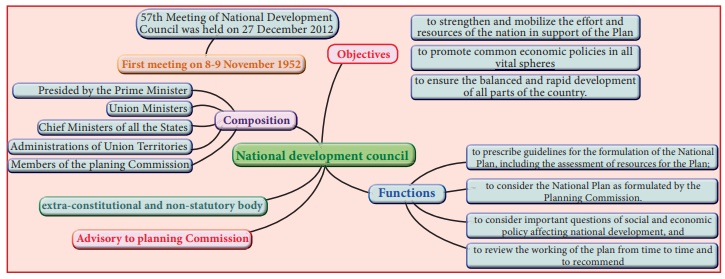
Efforts Towards Poverty Eradication
One of the major problems of India was
poverty. The Planning Commission aimed not only at increasing the per capita
income but also improving the quality of life of the people. Growth of the
economy necessitated the inclusion of all sectors. It was also understood that
the quality of life of the common man was interrelated to his economic
conditions. So, it was realised by the state that it was important to guarantee
people a decent standard of living along with proper access to education and
health care which are next to food, clothing and shelter. But the challenge was
that economic growth and reduction of poverty are not always related. From the
fourth five year plan, the government focussed on this issue and concentrated
on ‘garibi hatao’ during the early1970’s.
Employment generation was considered to be one of
the measures for reduction of poverty. There were many problems due to unemployment
and underemployment. In all the five year plans emphasis was given to employment.
Ensuring Social Justice
Article 38(2) states “The State shall, in
particular, strive to minimize the inequalities in income, and endeavour to eliminate
inequalities in status, facilities and opportunities, not only amongst
individuals but also amongst groups of people residing in different areas or
engaged in different vocations”. This was kept in mind by the planners in
formulating each of the plans.
Ensuring social justice has gone hand in hand with
economic planning. Along with measures for development, it is also important to
give equal opportunities to all with regard to education and employment. The
establishment of a socialistic pattern of society ensured that there will be no
concentration of wealth in the hands of a few so that exploitation and
oppression could be ended.
Historically, the Indian society has fostered
exploitation and suppression of one section by another. It was a challenge to the
constitution makers to tackle all these traditional forces and social evils so that
social and economic justice could be realized. The justiciable rights under
Part III of the constitution dealing with Fundamental rights enables the
citizens to get protection for all the rights required to live a complete life.
The non-justiciable rights under Part IV on Directive Principles of State
Policy ensures that the system functions in such a way that the inequalities of
income among people is reduced and an egalitarian society is established.
The rural urban divide was another important area
where the Planning Commission had to concentrate. In the process of economic
development, industrialization and urbanization increased and this had its
impact on the Indian society and economy. Disparity in the development of the
rural and urban population would foster inequality which is against the
principle enshrined in the constitution. The Planning Commission recommended
many programmes for the development of the rural economy so that the
development of both the rural and urban population could be ensured.
Manual Scavenging
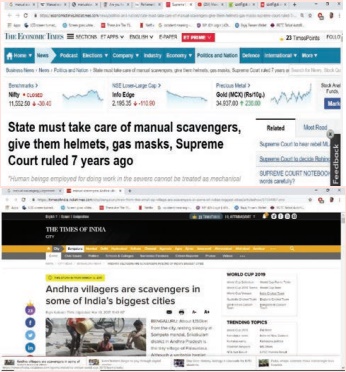
State instrumentalities and
contractors engaged by them are under a constitutional obligation to ensure the
safety of persons who are asked to undertake hazardous jobs such as manual
scavenging, the Supreme Court said in a landmark judgment seven years ago. But,
India continues human beings as manual scavenger in many cities.
The 2018 Global Multidimensional Poverty Index (MPI)
The 2030 Agenda for Sustainable Development reaffirmed the importance of multi-dimensional approaches to poverty eradication that go beyond economic deprivation. The 2018 MPI answers the call to better measure progress against Sustainable Development Goal 1 – to end poverty in all its forms; and opens a new window into how poverty - in all its dimensions – is changing. With the 2018 estimates, the MPI measures acute multidimensional deprivations in 105 countries covering 77 percent of the global population.
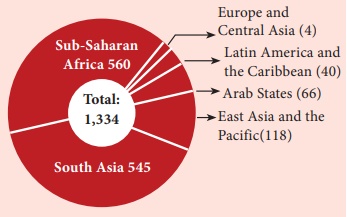
Democratic Socialism
When India got independence, there were many
problems that the nation had to handle. One among these problems was which
would be the best strategy for long term development. Jawaharlal Nehru was the
architect of planning in India. He was inspired by the soviet model of planning
and was also inspired by the liberal principles of capitalism. He wanted to bring
the two ideas together in India which was termed as democratic socialism.
Mixed Economy
The idea of a mixed economy was thus adopted which
included the liberal policy of encouraging private enterprises and also promoting
the public sector for the good of the society by socializing the means of
production and giving powers to the state to have control over the economy.
India is an inspiration to many nations for the idea of a mixed economy.
The Industrial Policy Resolution of 1956 was
adopted by the Indian Parliament in April 1956. It was a guideline for the
economic policy of the country. The five year plans were made on the basis of
this resolution. It emphasised on more powers to the governmental machinery so that
a socialistic pattern of society could be realized. The industries were divided
into three categories. Firstly, there were industries which were entirely state
owned. Secondly the category of industries which were state owned but the
public enterprises could also be included and thirdly industries which were
with the private sector. The state had control over all the industries and the
third category of industries could not function only for self interest or
profit motives but were regulated for the interest of the entire society. The
welfare of the community was the top priority.
Planning was considered to be a prerequisite for a
mixed economy. As the benefits of the public sector and the private sectors
were to be integrated for the welfare of the community, the Five Years Plans
were formulated in such a manner that the objectives of economic growth and
social justice could be achieved. It also made the governments to formulate
appropriate plans and adopt right strategies to bring about development in the
right manner.
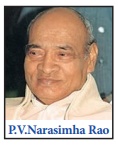
After the introduction of economic reforms in 1991
by the Congress government led by Prime Minister P. V. Narasimha Rao, a new
industrial policy was announced in July 1991 which aimed at taking steps to reduce
bureaucratic control over the Indian industrial economy and liberalization so that
the Indian economy could be integrated with the world economy. Restrictions on
direct foreign investment was removed. The reforms in the industrial policy was
reflected in areas such as industrial licensing, foreign investment, foreign
technology policy and public sector policy.
The seventh Five year plan got completed in 1990. Due to the economic condition of the country, the eighth five year plan could not be introduced in 1990. In the years 1990-91 and 1991-92 annual plans were formulated. The eighth five year plan was implemented in 1992.
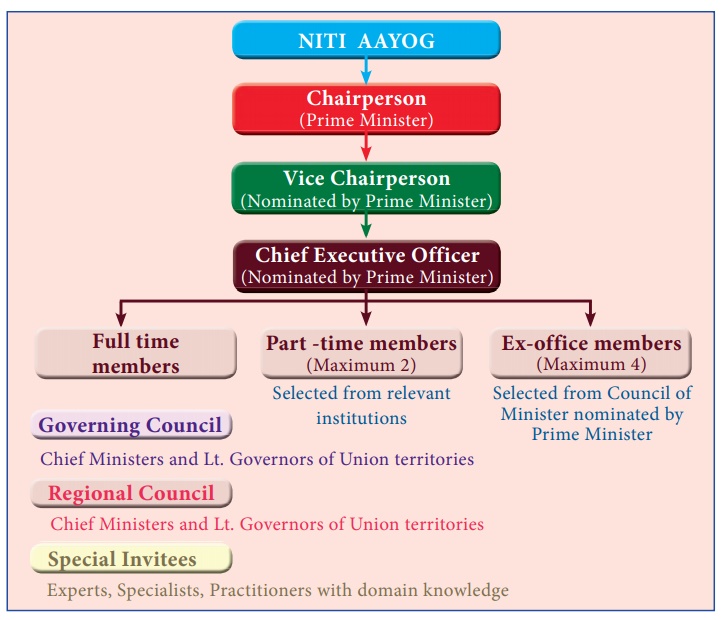
NITI AAYOG

The
National Institution for Transforming India
In 2015, the Government of India made a shift in
its approach towards planning. It introduced a new Commission called the NITI
Aayog (National Institution for Transforming India) which replaced the Planning
Commission. It was formed with the idea of making the entire planning process
more decentralized. In such a system the states could be involved in the
formulation and implementation of developmental plans in a better manner. It
aims at cooperative federalism where the states can play a wider role. It also focuses
on need specific plans making the entire process inclusive so that all sections
of the population could be a part of the developmental process.
The NITI Aayog functions as a think tank of the
government. It has the function of providing the central government and the
state governments with relevant and strategic technical advice relating to policy
making. It advices on all issues of national and international importance and
analyses on the best practices from our own country and from other nations of
the world. The Government issued a resolution of the Union Cabinet on 1st
January, 2015 by which the Planning Commission was replaced by the NITI Aayog.
Structure
The Prime Minister is the Chairman of the NITI
Aayog. He appoints a Vice-Chairman. There are 5 full time and 2 part time
members. It has a Governing Council which consists of the Chief Ministers of
all the states and Lt. Governors of Union Territories. The Regional Councils
are formed to address specific issues relating to the states or a region. It
functions for a specific period of time. The Prime Minister has the power to invite
experts, specialists and practitioners on particular domains as special
invitees. The part time members are from leading universities and research
organizations. Four members of the Union Council of Ministers are also nominated
as ex-officio members. It also comprises of a Chief Executive officer(CEO).
The plurality and diversity of the Indian state was
recognized by the government. The nature of each of the States and Union
Territories is different. The needs of the people are different, the
geographical condition of each of the regions vary and the economic conditions
are different. Some states are more developed than other states. So, the
government realized that a uniform plan of development for the entire nation is
not a right approach and will not give desired results. Thus,the NITI Aayog was
formed so that the needs of each of the regions could be addressed in the right
manner.
Why NITI Aayog Replaced Planning Commission: Reasons
1. The new National Institution for
Transforming India (NITI) will act more like a think tank or a forum, in
contrast with the Commission which imposed five-year-plans and allocated
resources to meet set economic targets.
2. NITI will include leaders of
India’s 28 states and 9 union territories. Its full-time staff - a Deputy
Chairman, Chief Executive Officer and experts - will answer directly to the
Prime Minister, who will be the Chairman. It is different from Planning
Commission.
3. The major difference in approach to
planning between NITI Aayog and Planning Commission is that the former will
invite greater involvement of the states, while the latter took a top-down
approach with a one-size-fits-all plan.
4. The Planning Commission’s role was
formulation of broad policy and its capacity was more advisory. NITI Aayog
shall have powers for resource allocation to states, based on their respective
needs.
5. The states had little direct say
in policy planning, which was the purview of the Planning Commission.
Involvement of the states was indirect through the National Development
Council; which is not the case in the NITI Aayog.
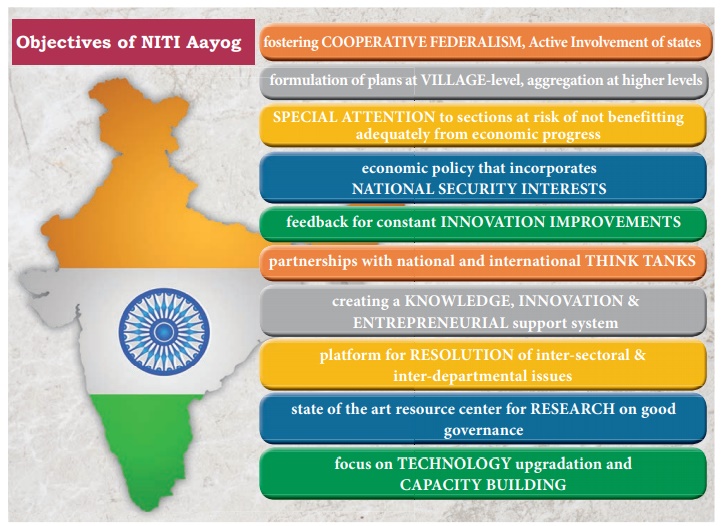
Objectives of NITI Aayog
The objectives of the NITI Aayog are:
·
TO include the States in the planning process so that
the Central government along with the State governments could identify
developmental priorities and strategies. This would foster cooperative
federalism as the states would be a part of the planning process. TO formulate
credible plans at the village level and aggregate it progressively. TO ensure
that the interests of national security are incorporated in economic strategy
and necessary checks on indiscriminate tampering with ecology and environment
policy and to check whether all sections of the population are benefitted from
economic progress.
·
Long term policy and programme frameworks to be
designed and their progress would be monitored by the Aayog and innovative
improvements would be made. Partnership between key stakeholders, like-minded
think tanks, educational and policy research institutions to be encouraged and
knowledge, innovation and entrepreneurial support system to be created through
a community of national and international experts, practitioners and other partners.
·
The Commission also offers platform for resolution
of inter-sectoral and inter-departmental issues so that the developmental
programmes can be accelerated. It maintains a state-of art resource centre
which will work for research on good governance and best practices in
sustainable and equitable development. It will monitor and evaluate the
implementation of the programmes so that needed resources could be identified.
·
The NITI Aayog also emphasises on technology
upgradation and capacity building for implementation of programmes and
initiatives. TO undertake other activities that are necessary to further the
execution of the national development agenda.
·
Some of the initiatives of the NITI Aayog include
“15 year road map”, 7 year vision, Atal Mission for Rejuvenation and Urban
Transformation(AMRUT), Digital India, Atal Innovation Mission etc. The NITI
Aayog signed the Sustainable Development Framework for 2018-2022. The
commitment of the government in attaining the sustainable development goals is
reflected by this. The areas that are focussed are poverty and urbanization,
health, water and sanitation, education, job creation, gender equality, youth
development.
·
The Planning Commission was set up by
a resolution of the Government of India in 15th March 1950. It has been
replaced by the National Institution for Transforming India, also called NITI
Aayog. It was formed via a resolution of the Union Cabinet on January 1, 2015.
The Prime Minister of India serves as the Chairperson of NITI Aayog.
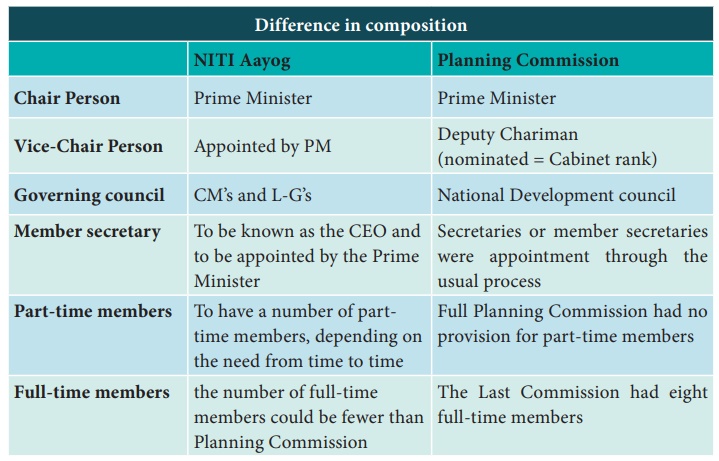
2018 MPI: dimensions, indicators, deprivation cutoffs, and
weights
The MPI looks beyond income to
understand how people experience poverty in multiple and simultaneous ways. It
identifies how people are being left behind across three key dimensions:
health, education and standard of living, comprising 10 indicators. People who
experience deprivation in at least one third of these weighted indicators fall
into the category of multidimensionally poor.
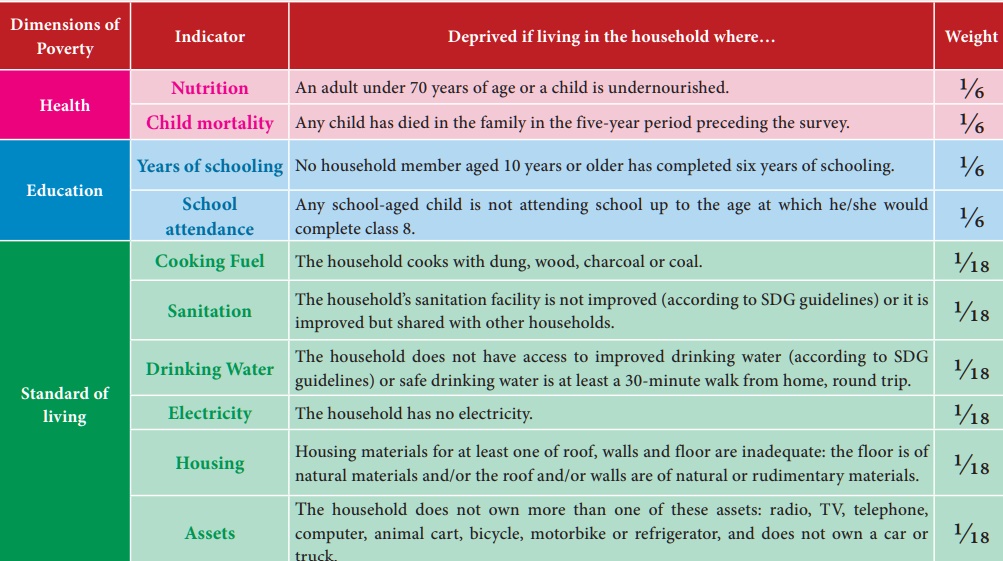
Activity: Identify the specific target and achievement focus of each
of the 12 Five Year Plans.
Activity
Think-Pair-Share
Topic 1 : Human development is the essence of social development
Topic 2 : Money cannot buy all the goods and services that one needs to live well.
Activity
I am thinking of
how to encourage our citizens to spend to get the economy moving.
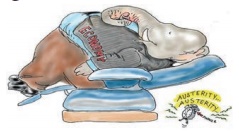
As a class, discuss
what you already know or think about the following topics:
1. Economic
activities of the State
2. Social welfare
of the people
3. Importance of
economic development
4. Socio-economic
justice
5. Employment
Activity: Have a
discussion on the working of NITI Aayog in your class under the guidance of
your teacher.
Related Topics